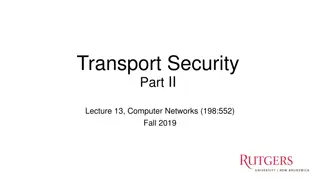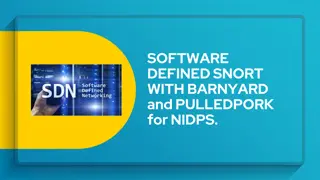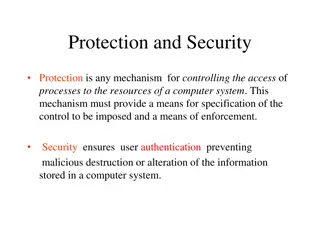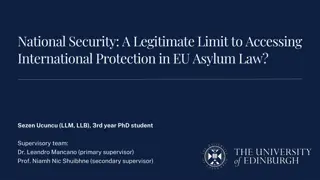IP Security Mechanisms for Network Protection
IP Security (IPSec) is a crucial aspect of network security that provides authentication, confidentiality, and key management. This article explores the architecture, services, and benefits of IPSec, including Transport and Tunnel Modes, emphasizing the importance of securing network communications.
Download Presentation

Please find below an Image/Link to download the presentation.
The content on the website is provided AS IS for your information and personal use only. It may not be sold, licensed, or shared on other websites without obtaining consent from the author.If you encounter any issues during the download, it is possible that the publisher has removed the file from their server.
You are allowed to download the files provided on this website for personal or commercial use, subject to the condition that they are used lawfully. All files are the property of their respective owners.
The content on the website is provided AS IS for your information and personal use only. It may not be sold, licensed, or shared on other websites without obtaining consent from the author.
E N D
Presentation Transcript
Chapter 19 IP Security If a secret piece of news is divulged by a spy before the time is ripe, he must be put to death, together with the man to whom the secret was told. The Art of War, Sun Tzu
IP Security have a range of application specific security mechanisms eg. S/MIME, PGP, Kerberos, SSL/HTTPS however there are security concerns that cut across protocol layers would like security implemented by the network for all applications
IP Security general IP Security mechanisms provides authentication confidentiality key management applicable to use over LANs, across public & private WANs, & for the Internet need identified in 1994 report need authentication, encryption in IPv4 & IPv6
Benefits of IPSec in a firewall/router provides strong security to all traffic crossing the perimeter in a firewall/router is resistant to bypass is below transport layer, hence transparent to applications can be transparent to end users can provide security for individual users secures routing architecture
IP Security Architecture specification is quite complex, with groups: Architecture RFC4301 Security Architecture for Internet Protocol Authentication Header (AH) RFC4302 IP Authentication Header Encapsulating Security Payload (ESP) RFC4303 IP Encapsulating Security Payload (ESP) Internet Key Exchange (IKE) RFC4306 Internet Key Exchange (IKEv2) Protocol Cryptographic algorithms Other
IPSec Services Access control Connectionless integrity Data origin authentication Rejection of replayed packets a form of partial sequence integrity Confidentiality (encryption) Limited traffic flow confidentiality
Transport and Tunnel Modes Transport Mode to encrypt & optionally authenticate IP data can do traffic analysis but is efficient good for ESP host to host traffic Tunnel Mode encrypts entire IP packet add new header for next hop no routers on way can examine inner IP header good for VPNs, gateway to gateway security
Transport and Tunnel Modes
Transport and Tunnel Mode Protocols
Security Associations a one-way relationship between sender & receiver that affords security for traffic flow defined by 3 parameters: Security Parameters Index (SPI) IP Destination Address Security Protocol Identifier has a number of other parameters seq no, AH & EH info, lifetime etc have a database of Security Associations
Security Policy Database relates IP traffic to specific SAs match subset of IP traffic to relevant SA use selectors to filter outgoing traffic to map based on: local & remote IP addresses, next layer protocol, name, local & remote ports
Encapsulating Security Payload (ESP) provides message content confidentiality, data origin authentication, connectionless integrity, an anti-replay service, limited traffic flow confidentiality services depend on options selected when establish Security Association (SA), net location can use a variety of encryption & authentication algorithms
Encapsulating Security Payload
Encryption & Authentication Algorithms & Padding ESP can encrypt payload data, padding, pad length, and next header fields if needed have IV at start of payload data ESP can have optional ICV for integrity is computed after encryption is performed ESP uses padding to expand plaintext to required length to align pad length and next header fields to provide partial traffic flow confidentiality
Anti-Replay Service replay is when attacker resends a copy of an authenticated packet use sequence number to thwart this attack sender initializes sequence number to 0 when a new SA is established increment for each packet must not exceed limit of 232 1 receiver then accepts packets with seq no within window of (N W+1)
Combining Security Associations SA s can implement either AH or ESP to implement both need to combine SA s form a security association bundle may terminate at different or same endpoints combined by transport adjacency iterated tunneling combining authentication & encryption ESP with authentication, bundled inner ESP & outer AH, bundled inner transport & outer ESP
Combining Security Associations
IPSec Key Management handles key generation & distribution typically need 2 pairs of keys 2 per direction for AH & ESP manual key management sysadmin manually configures every system automated key management automated system for on demand creation of keys for SA s in large systems has Oakley & ISAKMP elements
Oakley a key exchange protocol based on Diffie-Hellman key exchange adds features to address weaknesses no info on parties, man-in-middle attack, cost so adds cookies, groups (global params), nonces, DH key exchange with authentication can use arithmetic in prime fields or elliptic curve fields
ISAKMP Internet Security Association and Key Management Protocol provides framework for key management defines procedures and packet formats to establish, negotiate, modify, & delete SAs independent of key exchange protocol, encryption alg, & authentication method IKEv2 no longer uses Oakley & ISAKMP terms, but basic functionality is same
IKE Payloads & Exchanges have a number of ISAKMP payload types: Security Association, Key Exchange, Identification, Certificate, Certificate Request, Authentication, Nonce, Notify, Delete, Vendor ID, Traffic Selector, Encrypted, Configuration, Extensible Authentication Protocol payload has complex hierarchical structure may contain multiple proposals, with multiple protocols & multiple transforms
Cryptographic Suites variety of cryptographic algorithm types to promote interoperability have RFC4308 defines VPN cryptographic suites VPN-A matches common corporate VPN security using 3DES & HMAC VPN-B has stronger security for new VPNs implementing IPsecv3 and IKEv2 using AES RFC4869 defines four cryptographic suites compatible with US NSA specs provide choices for ESP & IKE AES-GCM, AES-CBC, HMAC-SHA, ECP, ECDSA
Summary have considered: IPSec security framework IPSec security policy ESP combining security associations internet key exchange cryptographic suites used























